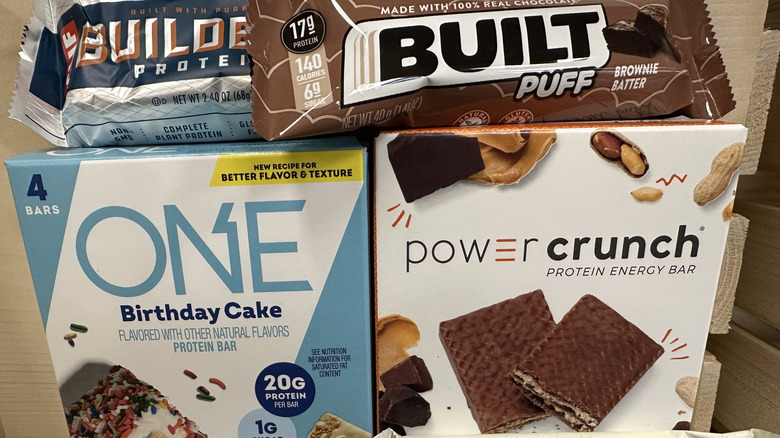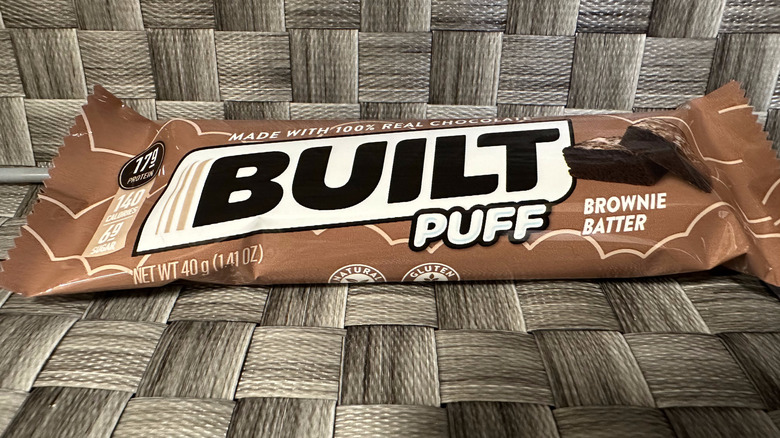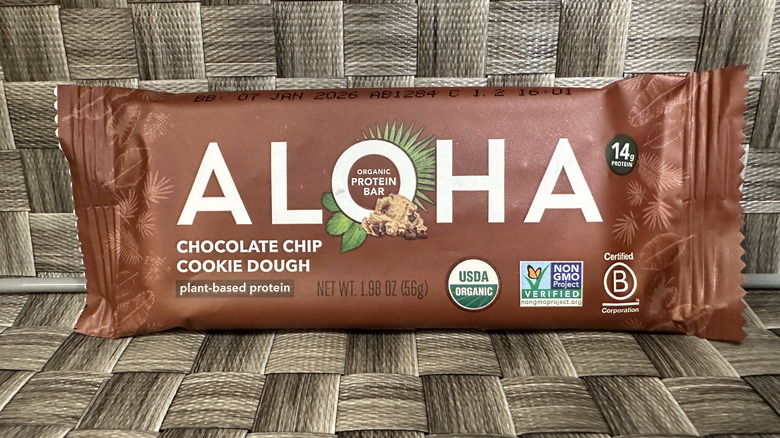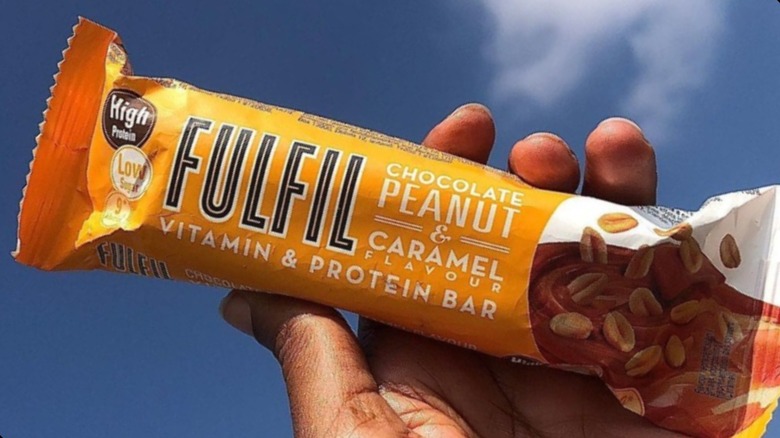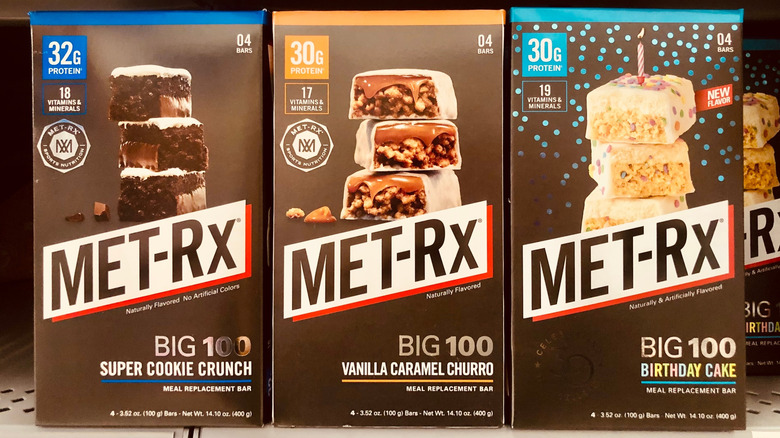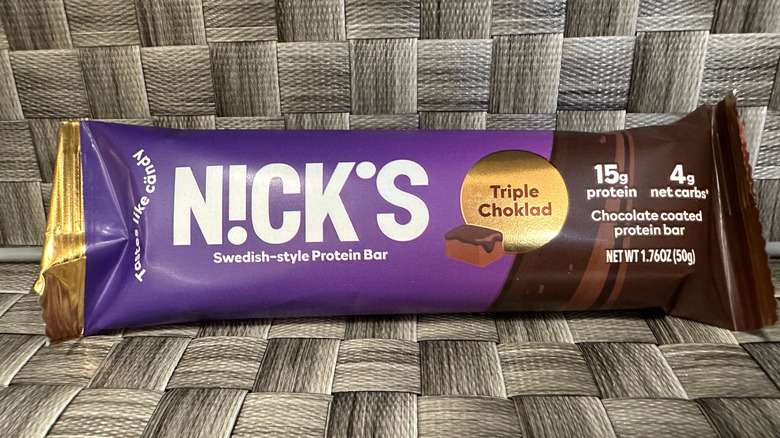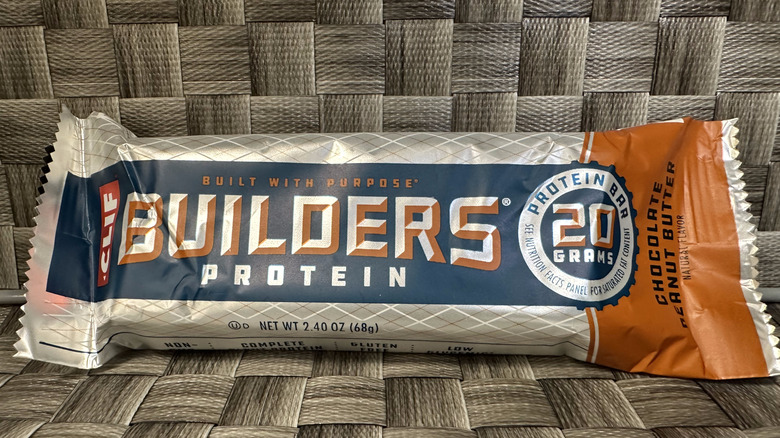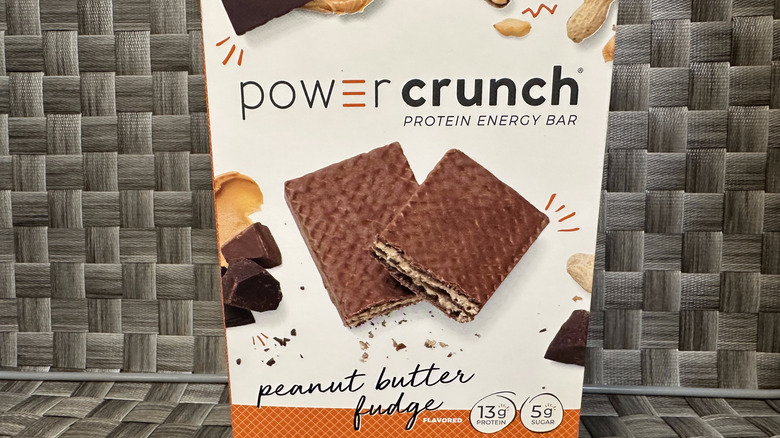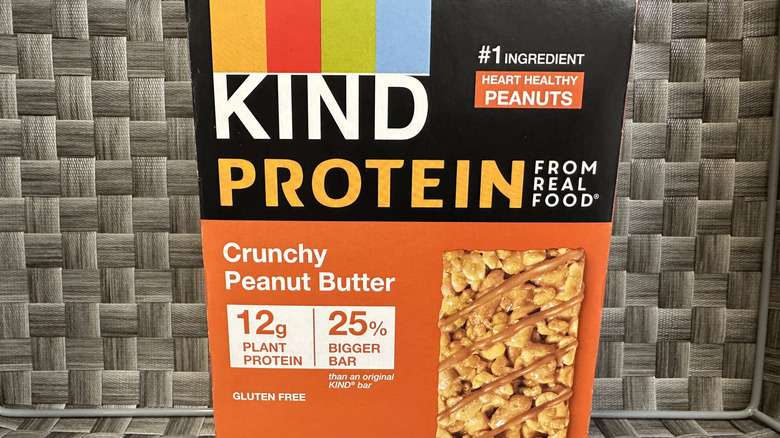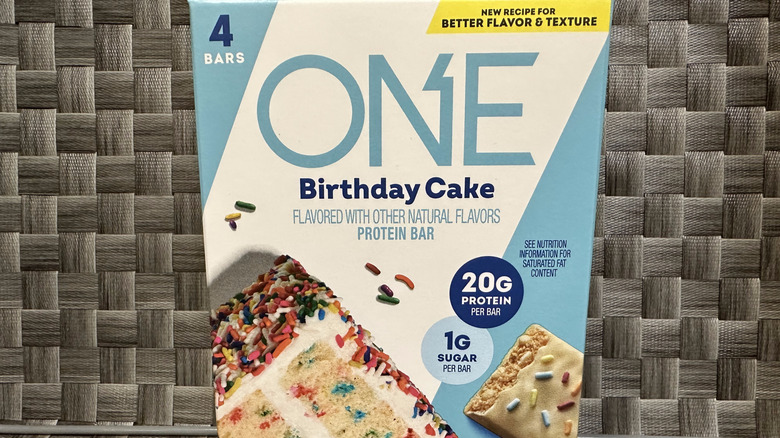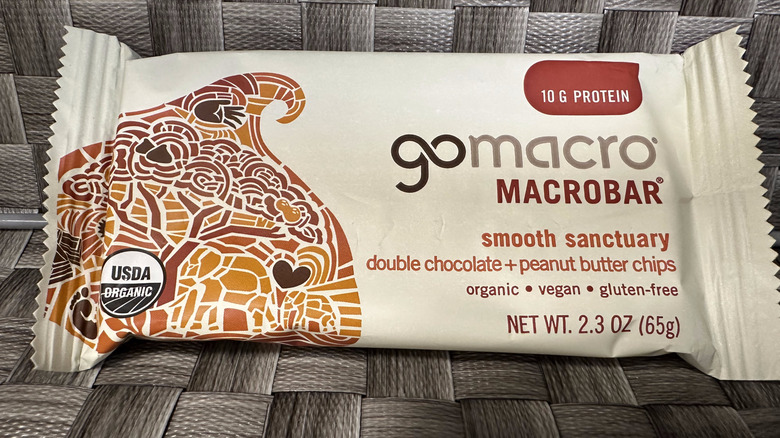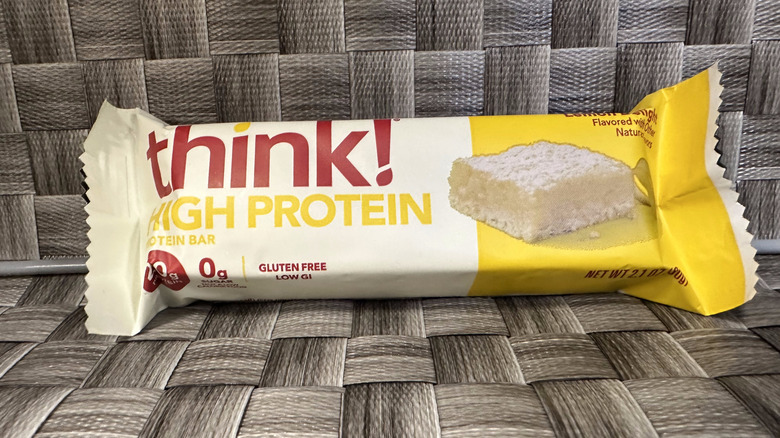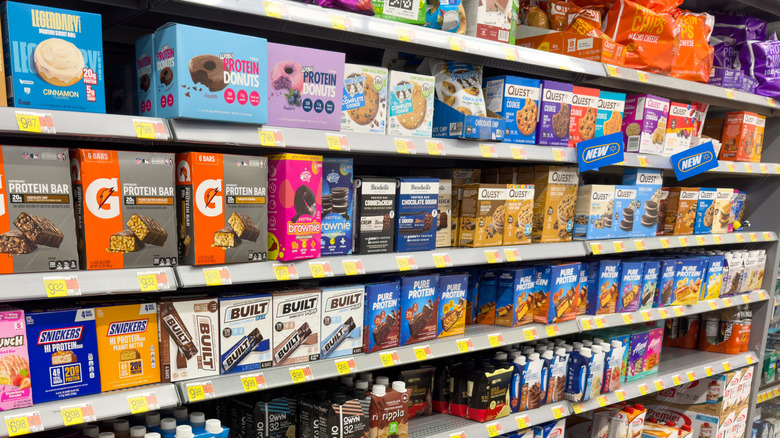6 Protein Bar Brands You Should Buy And 5 You Should Avoid
Protein bars are probably the closest we'll ever get to the futuristic food pellets depicted in old sci-fi movies. Convenient and efficient, protein bars became one of the definitive foods of the 2010s on their way to becoming mundane. While a regular adult probably doesn't need all the extra protein that these so-called supplements pack, they work great as a meal replacement option or something to grab to satisfy a sweet tooth while also benefitting from more nutrition than a candy bar. They're a reason to pay more attention to the breakfast aisle and possibly even a food to eat when you're feeling depressed.
There are so many qualities associated with protein bars — and such a demand for them — that the market has exploded. So many options greet consumers that it can be hard to figure out which one to buy. Not every protein bar is made the same — a handful taste positively wonderful and represent a great protein-grams-per-dollar ratio. Others just taste plain awful, or they're too expensive or not as nutritionally sound as some of their competitors. Here then are the six protein bars to look out for, purchase, and enjoy, and five that one should probably skip.
Buy: Built Puff
The makers of collagen-infused foods make a lot of bold claims and big promises, but protein bars just might be the place where that dietary supplement can make a big difference both in terms of nutrition and taste. Regular consumption of collagen, a protein that naturally occurs in the human body, can build elasticity and keep the body working correctly, which is what the marketing materials for all protein bars more or less promise. A nice side effect of the use of collagen in Built Puff protein bars is that it gives the product a chewy, fluffy, moist, and soft texture that's almost never found in protein bars. The inside of a Built Puff bar tastes and functions like a marshmallow or nougat. It also adds a velvety mouthfeel that, when combined with the objectively delicious chocolate on the outside, turns a Built Puff bar into a treat, reminiscent of something halfway between a chocolate-covered marshmallow Easter egg and a Charleston Chew.
But this thing is way more healthy to eat than an ordinary candy bar. With 200 calories and around 12 grams of protein in a bar, it gets the business done with a lot of pleasure, too. There's not even an aftertaste of protein, merely the lingering flavor of decent chocolate.
Avoid: Aloha
One glance at the wrapper of an Aloha plant-based protein bar should tell consumers everything they need to know about the product inside. They ought to expect something mild, wholesome, and untoward as well as something that tastes like real food, as Aloha's nutritional treats are low on processing and scientifically modified ingredients, which is notable for such a lab-based creation as a protein bar. As these bars are certified organic and made without the use of genetically modified ingredients and are expressly plant based, it's very confusing and off-putting then when a bite of an Aloha bar reveals its true nature: It tastes like a raisin that's been doused in chemicals. This is not the feeling that a dessert-inspired bar should provoke.
Like a thinner version of a protein bar of yore, an Aloha is a sticky brick that smells like solvents. The protein bars certainly don't taste like peanut butter, chocolate, cookie dough, or whatever the wrappers promise. They're tough to chew and hard to swallow, and they live up to all those bad old jokes about how organic foods are tasteless and have a terribly slimy texture.
Buy: Fulfil
Fulfil protein bars are priced competitively relative to other protein bars — about $2 a pop — which isn't much more than a mass-produced, name-brand candy bar. This all means that for just a few pennies more, customers who choose Fulfil's chocolate salted caramel variety get all of the benefits of a protein bar — 15 grams of protein, a hint of fiber, and very little blood glucose-spiking sugar — but with the taste of a 100 Grand Bar.
That flavor of Fulfil tastes almost exactly like a 100 Grand, made as it is with chocolate, caramel, and puffed, crispy rice. What Fulfil's makers do differently is get rid of the carbohydrate-loaded rice and replace it with soy bits, which bulk up the protein count. Not only can you not taste that soy lurking below all that chocolate and the light, imitation caramel, but it doesn't leave an aftertaste either. Other varieties of Fulfil are just as fulfilling and can convincingly hang with the protein-light, sugar-heavy candy bars. The chocolate peanut caramel is reminiscent of a Snickers, the chocolate hazelnut tastes like Ferrero Rocher candies, and the chocolate peanut butter is a decent duplication of a Reese's Peanut Butter Cup.
Avoid: Met-Rx
There's a hint about what it's like to eat a MET-Rx protein bar in its name. That "Rx" makes one think about prescription medicine, and that implies an arduous experience, one that will be unpleasant on the surface but that you know, on some level, is good for you. And yes, MET-Rx bars of all kinds are a healthy choice, at least in terms of protein. Just one bar packs between 30 and 32 grams of protein, more than twice the industry average.
That protein doesn't come for free, however. Met-RX bars not only contain twice as much protein as most any other bar, but they cost about double, too, with a per-unit price approaching $4. It costs a lot to include all that protein, and apparently a lot to unsuccessfully mask the pungent and awful taste of all those dry, soy bits. Each bar is caked in what is supposed to be chocolate. But it just tastes like chocolate-flavored chalk. That adds to the high calorie count: around 400 calories per serving. At least the calorie level indicates that a bar is a meal replacement, not a snack or a supplement. But good luck to whoever tries to eat one of these, with varieties that don't resemble in the slightest their inspiration, be it churros, cake, or cookies.
Buy: Nick's
Nick's protein bars taste so good that one wonders why every other protein bar manufacturer isn't imitating its science and cookery. Protein rich and low in sugar, these don't taste, feel, or behave like other nutritional supplements in any way. They're just candy bars that happen to have a lot of protein — a bountiful 15 grams on average — and not a lot of havoc-spreading sugar. But Nick's recipes don't employ the use of crunchy, bone-dry, and bitter soy isolate protein nuggets. These are lovingly crafted chocolate bars where everything everywhere is smooth and luxurious.
Created in what the label calls Swedish-style, Nick's Triple Choklad bar could be mistaken for an imported, high-end craft chocolate. It's just sweet enough to allow the complex, layered chocolate to sing. A slight caramelization occurs, but that takes over in the Karamell Choklad bar, which creates a ratio of caramel to chocolate not seen outside of a roll of Rolo candies. But somewhere in there, in one of Nick's competitively priced protein snack bars, is a hefty dose of thankfully undetectable protein.
Avoid: Clif Builder
They're actually called "Clif" bars, not "Cliff" Bars, although the whole gamut of items by the nutritional supplement company uses imagery of cliffs on its packaging, clearly to suggest to the consumer that eating one of its bars infused with rice syrup and soy protein will give them the energy and stamina they need to climb such a thing. Clif Builders bars are quite aptly named, however — these offshoots of the flagship Clif Bar line seem to be made of rock, and it just may require a steely resolve and plenty of protein bars to get up to the task of eating one.
While that's a texture of which no nice words may be said, a Clif Builders protein bar — different from a regular Clif Bar in that it has way more protein and a bit less sugar — tastes somewhere in the neighborhood of fine. Like a popular candy bar, a Builders bar is likely to include a truffle or nougat layer that contains all of the bar's promised, and winning, flavor such as chocolate mint. That sits atop a layer of those omnipresent soy protein bits, which here poke out from a mess of chocolate-flavored dirt that tastes just as bad as the soy. That mirrors the glazing of outside chocolate, which at least is applied lightly so it doesn't totally drench the bar in bitterness and cloying fake-sweetness.
Buy: Power Crunch
So many protein bars are thick, heavy bricks of food — maybe customers take them more seriously that way, and their utility and seriousness of approach to nutrition are more understood if they're rendered as such joyless monoliths. Power Crunch dares to be different, turning out a product that's consistently light, airy, and crisp. Clearly inspired by wafer-style sandwich cookies, Power Crunch protein energy bars are crispy, flaky, and sweet in the middle, and all that goes underneath a just-right thickness of chocolate or other coatings that complements it with its velvety taste and texture.
Rather than present the soy protein in nuggets, Power Crunch buries it inside the paper-thin wafers. That gets rid of the terrible, mouth-enveloping soy taste and aftertaste. The process also makes them so lightweight that they quickly melt, assisted by the milky coating. Not only do Power Crunch bars get out of their own way to the point where the bars taste like less healthy cookies and candies, but they're inexpensive, too. They pack as much or more protein than their competitors, all while sold at a best-in-class per-unit price of around $1.75.
Avoid: Kind Protein
So confident in its products, Kind once paid consumers $100 to eat a competitor's energy bar. But it might need to reverse that promotion with Kind Protein, a spinoff line focused on providing more protein than the flagship products. The original Kind bars are no slouch in that area, proudly and prominently packed with protein-rich nuts and actually little else. That doesn't provide as much of the nutrient as heavily processed crispy soy bits, however, so Kind Protein uses those, just like so many other protein bar manufacturers.
While that ups the nutritional content, it also kills the taste. Kind Protein bars predominantly and unpleasantly taste like soy protein isolate, which is a bitter, medicinal sensation coupled with a dryness that calls for a pairing of food with a couple glasses of water. Added flavoring agents like peanut butter — an artificial seasoning, not actual peanut butter — doesn't add much to the product. Rather than masking the taste of soy, it just places another bad layer on top of it. At least the light chocolate coating Kind Protein uses is tasty, at first, before it leaves a strong and difficult aftertaste.
Buy: One
It seems to be difficult to create a protein bar that's not only loaded with important nutrition and a meal's worth of protein but also tastes good and reminds the consumer of the classic dessert that the bar purports to emulate. But the team at One achieved the difficult task of making a whole line of bars that provide everything one can ask out of a protein bar. With levels of protein and sugar on the far high and far low ends of the spectrums — 20 grams and 1 gram, respectively — One protein bars are an easy and quick way to get dietary protein. They're also enjoyable to eat.
Thanks to the modern magic of food science, they actually taste like the objectively unhealthy treats pictured on the packaging. A S'mores bar gives off not just the taste of graham crackers, marshmallows, and milk chocolate, but it nails those different textures, too. Birthday Cake bars get across both yellow cake made from a powdered mix as well as powerfully sweet canned vanilla frosting. The Maple Glazed Doughnut bar could feasibly replace a morning maple bar habit.
Avoid: GoMacro
How can something that's supposed to be so pure and natural smell so foul and phony? And how can a product so honest and upfront with the consumer about what's in it taste nothing like what it says it's supposed to taste like or even like its stated ingredients? These are baffling conundrums posited by the protein bars sold under the GoMacro brand name. Completely free of gluten and animal products and also organic, GoMacro gets a lot of isolated protein from plant-based sources into a bar, which must be the source of the wretched chemical odor emanating off the bars, similar to that of nail polish and also cheap, imitation vanilla extract.
Fortunately, the smell goes away when you bite into a GoMacro MacroBar. Therein lies another mystery: GoMacro bars don't taste like much of anything. If the wrapper says it's an oatmeal bar, and the ingredients list notes oats, it should taste like oatmeal. But it doesn't. Nor do chocolate chips make an impact. They're used hyper-sparingly by GoMacro as if to provide a surprise hint of crunch inside of a very soft bar. There's a more prominent aftertaste than regular taste, and that one features notes of tree bark and smoke. Don't pay premium prices for an organic, sub-par protein bar.
Buy: think!
With its name, the entire line of think! bars urges traditional sweets-wanting customers to take a moment and make a sensible choice by selecting a bar that's full of protein and might actually be pleasant to eat as well. A think! High Protein bar, while just a small rectangle, is different from most other bars with which it shares shelf space in that it's got a lot of the main, spotlight ingredient (around 20 grams of protein per serving), and it doesn't overwhelm. Both the chocolate-based and fruit-oriented styles of think! High Protein are light and subtle in terms of flavor, texture, and mouthfeel. If protein bars are intended to provide a boost of protein that refreshes a weary body, think! products do just that, and they taste that way.
Among the better varieties is the Lemon Delight. With a picture of a powdered sugar-laden lemon bar on the wrapper, expectations are high, but it really delivers, giving a quick burst of natural citrus flavor and finishing off with candied lemon. It doesn't taste like a lemon bar, but it does taste like lemon yogurt, up to and including the not unwelcome sweet and tangy aftertaste.
Methodology
Protein bars assessed for inclusion in this article, in both the buy and avoid columns, were selected based first on widespread commercial distribution. The bars rated and ranked are sold in a wide variety of retail environments, like supermarkets, drug stores, and convenience store chains. Because there are so many protein bars available, the ones picked are those that best live up to their product category's name — they all have a lot of muscle-building and hunger-satiating protein. Each bar tested had at least 12 grams of protein per serving (or per bar).
They were then rated on taste along with adjacent factors that affect the enjoyment of the bar, like mouthfeel and odor. Bars with a taste or aftertaste that was too bitter or that seemed like medicine, imitation sweeteners, and soy, didn't earn high marks. Ones with a great balance of flavor, or that buried the unpleasant taste of soy pellets, or tasted like regular, non-protein enhanced candy bars, scored favorably. All that subjective data was combined with more objective information, like protein content and cost, to arrive at a well-rounded assessment of each protein bar.
